 Teacher Feature...
Teacher Feature...
Non-Conventional Techniques in Teaching Science
by P R Guruprasad
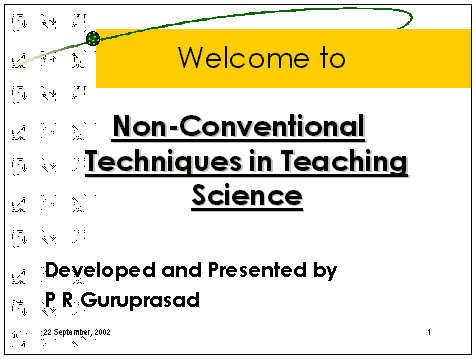 Click the image for a larger view.
Click the image for a larger view.
I have developed this material with the Indian context in mind where most classroom teaching is chalk n' talk, reasons for which include the following: substandard, outdated and irrelevant teacher training courses, vague syllabus documents and lack of public awareness for quality education. However, I must they say that there are exceptions but they are a drop in the ocean considering the population density of India.
Let me take you in my time machine 30 years backwards, to the year 1962. I am one among the 40 odd children in standard 7 ['standard' is the Indian equivalent of the US 'grade']. My science teacher teaches the concept 'Objects expand when heated'. He is, as usual, using chalk n' talk. None of us understand the lesson. Next day, questions are asked and kids baffle. The science teacher plays his favourite metamorphosis: he becomes a 'beater'.
In the same school, there is another science teacher [who as headmaster of the above mentioned school, has far more academic workload than my science teacher]; he is taking a science class in standard 10 at the same time; I can see him demonstrating parts of a dog's brain and engaging students in discussion [the local vet. is a friend of the headmaster and hence it is easy to procure materials for school use]. Students in standard 10 are always interested in science. The reasons are obvious.
Let us get back to the present: year 2002. The headmaster of the school was my own father. In those days, it was customary for the headmaster to take only higher classes in the school [anyhow, I never needed to worry much, as my mother, a housewife, taught me science back home using the kitchen and other resources available in the house].
The point is, within the Indian context, any teaching method which goes beyond the chalkboard, can be termed non-conventional. [Anyone, who takes a visit to school science classrooms here can understand what I mean, a painful reality, 54 years after independence!].
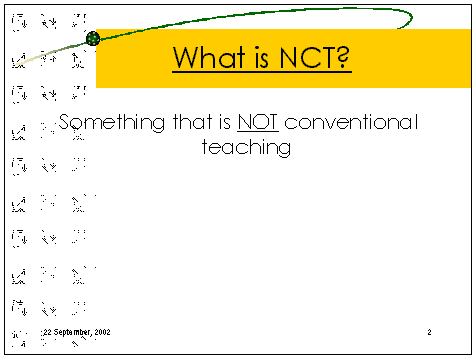 Click the image for a larger view.
Click the image for a larger view.
Two middle school science classrooms A and B. Both the classes are going to be taught the concept 'White light is made up of seven major colors'. In A, the teacher draws a nice picture of the triangular glass prism and 'illustrates' the process. In B, the teacher enters the class with some plastic rulers and white sheets of paper, distributes them to the kids and asks them to go out in the sun, keep the paper under the ruler and see the sunlight which has passed through the ruler onto the paper. As teachers, it would be obvious to us as to which class would have enjoyed the activity and understood the concept more effectively.
Though there are several methods that could be employed at the concept introduction level. Educational research continues to prove that Activity Based ones are the best [thanks John Dewey, Vygotsky, Jean Piaget, R Tagore, D P Ausubel, M K Gandhi, or more recently R Driver et al].
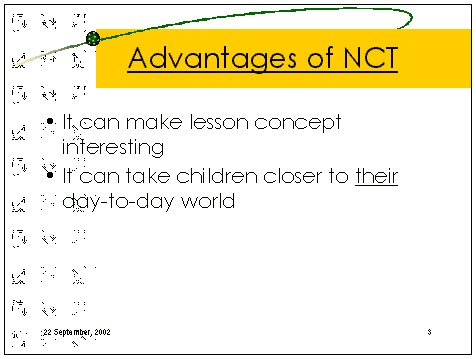 Click the image for a larger view.
Click the image for a larger view.
As we have seen in the above examples, NCT gives opportunities for kids to take an active role in classroom process [I have many times seen them excited in acquiring ownership of the situation and this has led to increased self confidence among them].
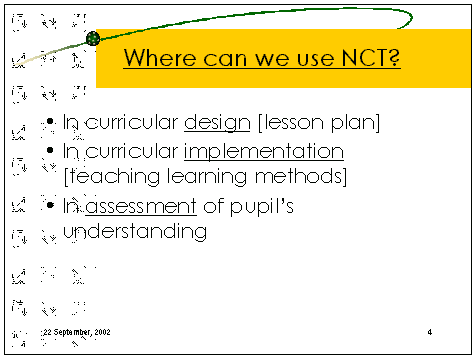 Click the image for a larger view.
Click the image for a larger view.
As teachers it is not difficult to implement NCT in curricular design and implementation once a start has been made. But how to include NCT in assessment of pupil's understanding? Or more precisely, how effectively can we assess pupil understanding of science concepts by applying NCT?
This is an issue which seems to be ignored by syllabus boards, textbook publishers and exam boards alike, in countries like India. A look at school science textbooks published in India would reveal the truth in what I am talking about.
Following are a few classroom science examples where I have tried to include NCT in assessment [in all these cases, I have ignored the textbook and let my kids do it too, as the textbooks were 'not' up to the mark]. Each of the following is a problem situation given at the end of the lesson:
You are playing table tennis. While giving a hard service, your ball gets deformed ['smashed']. How can you rectify the problem?
Your are on a weekend outing; you lost your water bottle. You are very thirsty but there is only one small tea-shop in the village en route. It is better to test the tea before drinking so that you don't end up having acidity in your stomach. How will you test the water?
A small bird [of the size of your palm] is caught in 1 foot hole in a the wall of a construction site. The bird is newborn and hence very tender. As a good kid, how will you try to rescue the bird?
Your are living in the ground floor of a high rise apartment block. When water stops coming in the tap, you usually go to the rooftop, check the water level in the overhead tank and do the needful. How can you monitor the water level in the tank without moving up from your ground floor every time the water stops? [The lift system in apartments come to a stand still at times].
As we can see, each problem situation warrants the use of some school science concept or the other. I have found such assignments to be of immense long term benefit to kids years after they graduate from school!
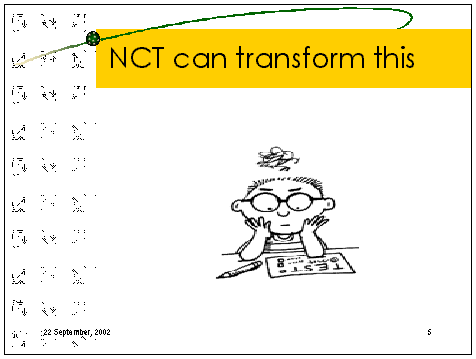
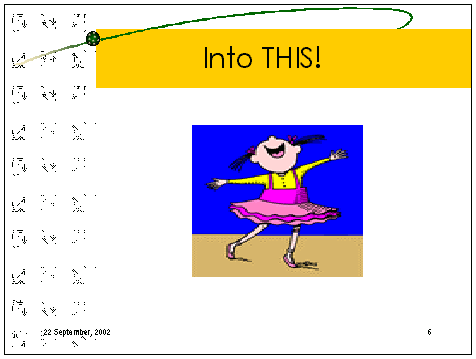
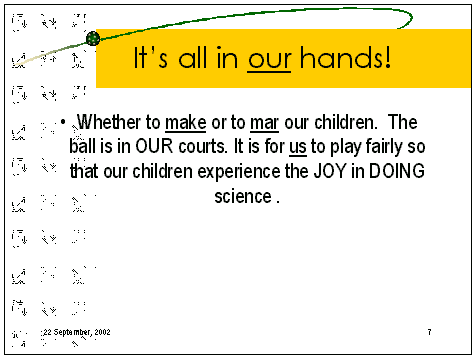
You can download this article in its original PowerPoint format here - NC inTeachingScience.ppt
If you do not have PowerPoint installed on your computer, you can download a free copy of PowerPoint Viewer here - http://office.microsoft.com/ downloads/2000/Ppview97.aspx
Browse the Science Teacher Chatboard at
http://teachers.net/mentors/science
| 
